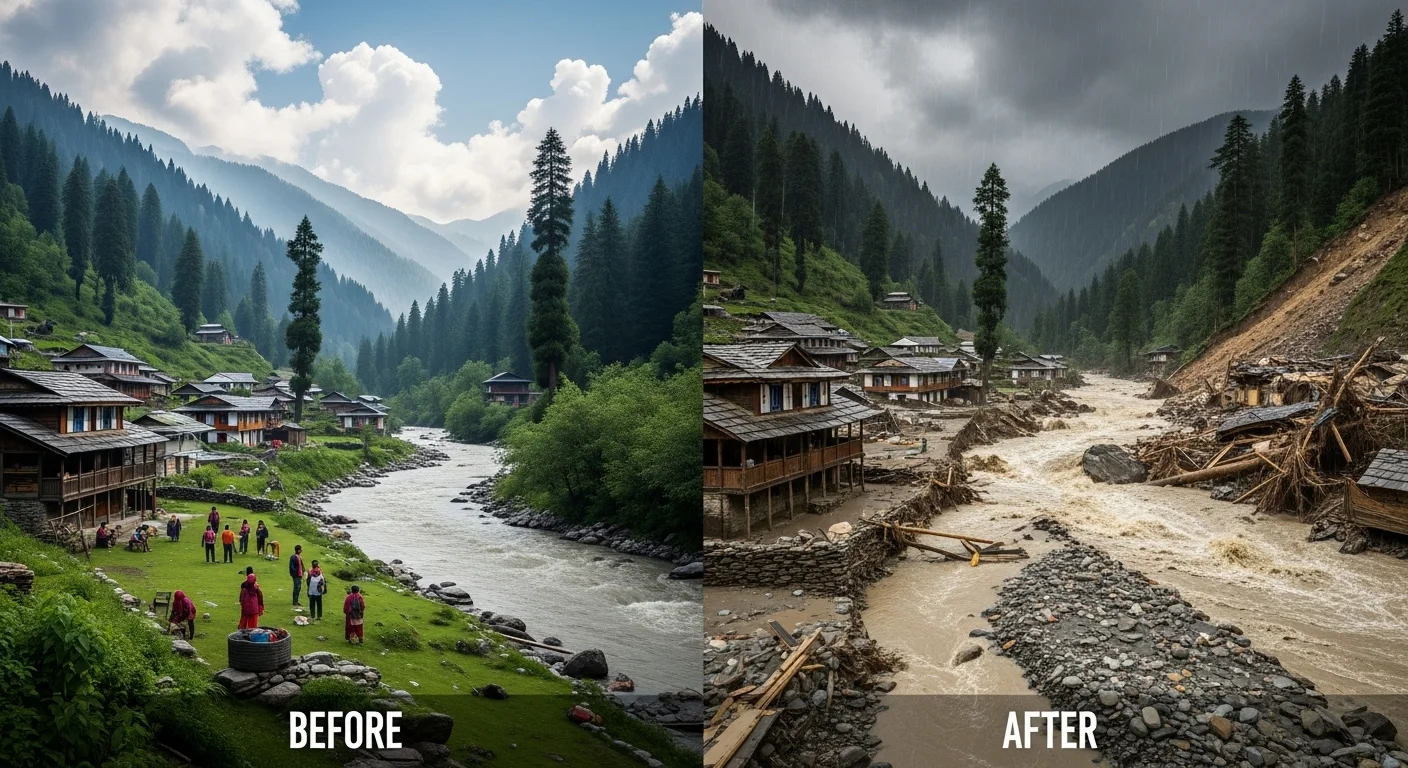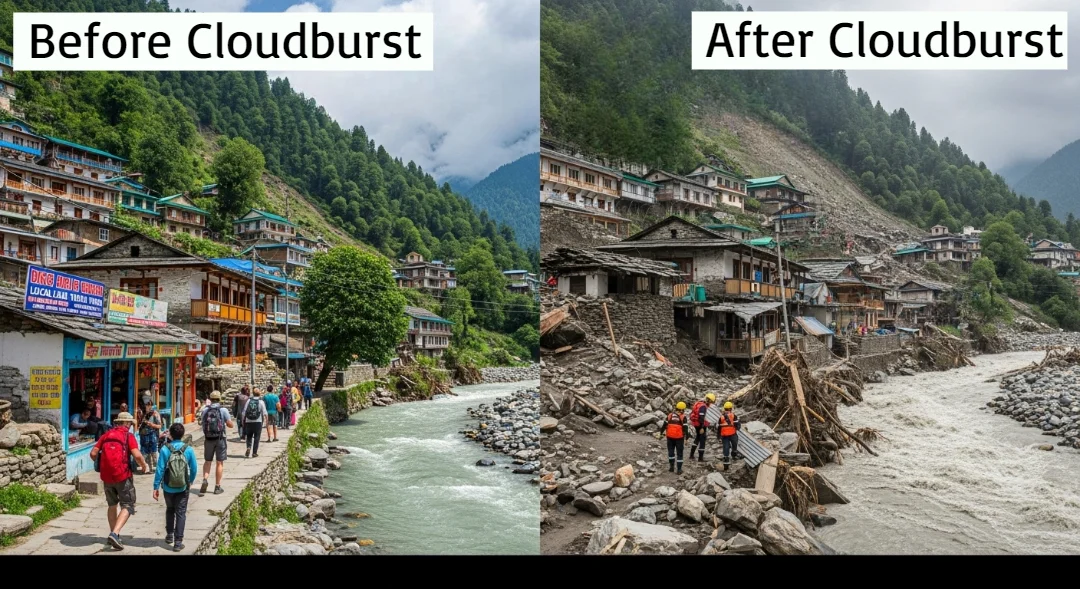Nestled deep in the Garhwal Himalayas, just 18 km before the holy town of Gangotri, is the peaceful village of Dharali. It is best known for its pristine mountain views, spiritual qualities, and enormous apple orchards. Sadly, all that changed during the cloudburst of August 2025, when this beautiful area of Uttarkashi became a disaster zone, and more significantly for its people, unrecognizable.
This article will investigate the before and after of this tragedy; what made Dharali special, what we lost after the cloudburst in 2025, how much of a loss it has been for the tourism sector in Uttarkashi and what it might look like moving forward.
Dharali Before the Cloudburst: A Hidden Jewel in the Himalayas
Dharali was often passed over for the more popular and better-known Gangotri, however, for those that knew it, and especially in comparison, the village of Dharali was peaceful, unique and pure. That is, until the rain began. The village existed along the boulders that line the banks of the near glacial blue Bhagirathi River, and was known for:
-
Apple orchards, popular among visitors and nature lovers
-
A beautiful, serene and idyllic setting that beckoned spiritual seekers and Yoga practitioners.
-
The mountainous backdrop and close proximity to the mountainous trekking hub of Gangotri National Park
-
The authentic wooden village houses and friendly Garhwali people”
Eco-tourism had just started to blossom, in the form of homestays and local guided excursions, to promote a deeper experience in the Himalayan region.
Also Read: Uttarkashi’s Dharali Hit by Cloudburst: Havoc Wept Havoc Widely and Why is This Happening?
A Cloudburst: What Happened on the Night of August 5, 2025?
The night of August 5, 2025 brought with it a cloudburst over Dharali, an intense burst of rainfall which was localized and more than 100 mm (over 4 inches) of rain fell in less than an hour. The downpour caused…
-
Landslides that destroyed homes, roads, and bridges
-
Flooding of the Bhagirathi River which then scoured away structures along the river
-
Year-long destruction of crops especially the apple orchards
-
Complete cut off of road connectivity for both locals and tourists
-
Death of humans, animals, and livelihoods
Search-and-rescue attempts started immediately but the damage had been done. The very elements that made Dharali attractive to its visitors: rivers, mountains, and remoteness, were now creating a destruction zone.
The Scientific Explanation of the Disaster: Why Did the Cloudburst Take Place?
While cloudbursts occur frequently in the Himalayas, several reasons underscored the intensity of this event:
-
Climate change has increased the frequency and intensity of extreme weather processes in this area.
-
Deforestation combined with unrestricted construction have made slopes unstable and enhance the occurrence of landslides.
-
The absence of warning mechanisms and preparedness plans for these disasters has made the disaster compound itself.
Meteorologists observed that rapid abatement of temperature and moisture levels over the Gangotri valley created the right conditions for this type of storm to contact the valley.

Immediate Effects on Local Community
The residents of Dharali were in shock: whole families lost homes. The local economic activity that relied on agricultural and farming-based tourism was completely halted. Some of the first issues facing the community included:
-
Displacement of hundreds of villagers
-
Collapse of critical infrastructure including electricity, mobile networks, and roads
-
Interruption of spiritual tourism; a vital path to Gangotri was temporarily strewn with rocks and other debris
-
Long-term impacts on mental health associated with trauma and loss
The village that only days before, had welcomed pilgrims and tourists into its heart, now lacked basic necessities such as clean water, medical care, and shelter.
Impact of the Disaster on Tourism in Uttarkashi
Tourism across the entire district of Uttarkashi was indirectly affected by the cloudburst, especially at:
-
Gangotri Dham saw a significant decline in visitor numbers to the pilgrimage.
-
Nearby villages include Harsil, Bhatwari, and Mukhwa, who also rely on some of the same route networks.
-
Local homestays and small hotels, many of which were damaged and/or abandoned.
Tourism is an important part of the economy here, especially in the Char Dham Yatra season. The sudden cessation of business does not only mean lost revenue, it also raises questions in tourists minds about traveling in the Himalayas.
Also Read: Uttarakhand Travel Alert: Uttarkashi-Harsil Road Blocked by Cloudburst and Landslides, Rescue Efforts Underway
Environmental and Spiritual Significance at Risk
Dharali isn’t just a scenic village—it holds deep spiritual significance. Located along a river considered sacred, the region has long been a site for meditation, ritual dips, and temple visits. The cloudburst raised alarms about:
-
The fragility of Himalayan ecosystems
-
The loss of sacred spaces that are vulnerable to climate disasters
-
The disconnect between development and environmental sustainability
Government Response and Relief Efforts
In the days following the disaster, relief operations were initiated by the Uttarakhand State Disaster Response Force (SDRF), Indian Army, and NGOs. Key steps taken included:
-
Evacuation and rehabilitation of affected villagers
-
Setting up of temporary shelters and medical camps
-
Restoration of road connectivity, especially toward Gangotri
-
Promises of compensation and reconstruction funds from the state and central governments
However, many criticized the delayed response and the lack of early-warning infrastructure, which could have minimized the damage.
Rebuilding Dharali: A Call for Sustainable Tourism
As the region begins to heal, experts and local leaders are calling for a shift toward sustainable, disaster-resilient development. Recommendations include:
-
Limiting construction in ecologically fragile zones
-
Implementing green building techniques and better drainage systems
-
Promoting community-based tourism that prioritizes local knowledge and safety
-
Establishing climate early warning systems and disaster preparedness drills
The Road Ahead: Hope in the Rubble
There is a deep sense of resilience among the people of Dharali. They are beginning to rebuild, and the village is slowly regaining a sense of order. As the roads reopen, pilgrims to Gangotri are expected to start returning and that hopefully tourism will be revived—with a stronger chance it will be more responsible and aware.
The cloudburst of 2025 taught us all that nature can strike suddenly and ferociously, particularly in the fragile Himalayas. Yet, it also revealed to us the strength of mountain communities and the need to protect the sacred landscape of the Himalayas.
Final Thoughts
Dharali can be told as a story of beauty, loss, resilience, and reflecting. The village is recovering from the cataclysmic cloudburst, and it is a powerful story that asks you to consider the repercussions of the limits of the ecology. For travelers, Dharali not only becomes a destination but a sense of what is at stake for us, in an age of climate change. In order to appreciate the Himalayas, we must learn to not only take in its magnificence but to also acknowledge its fragility.







